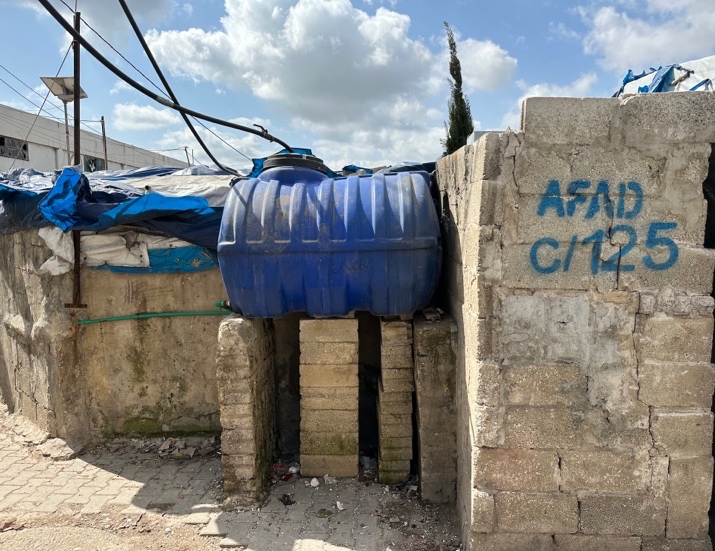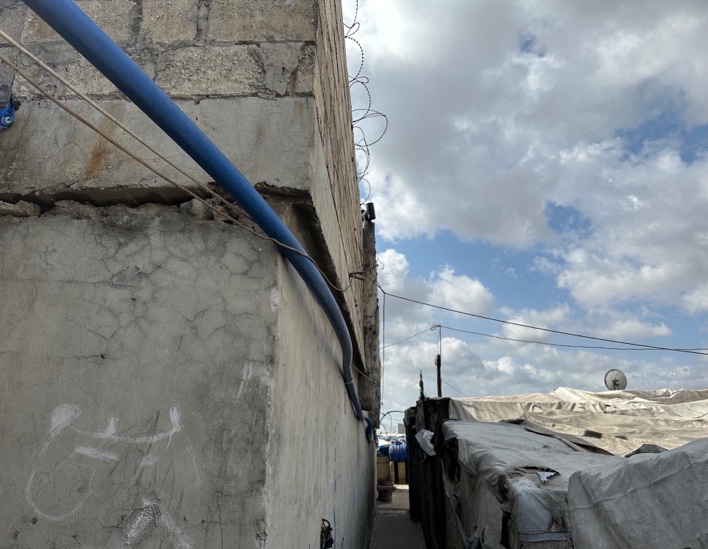by Thomas Fergusson | April 10, 2023
Acronyms
- ACU – Assistance Coordination Unit
- AFAD – Turkeys Ministry of Disaster and Emergency Management
- AWD – Acute Watery Diarrhea
- CTC – Cholera Treatment Center
- HTH – High Test Hypocrite
- IEC – Information Education and Communication
- IHH – Humanitarian Relief Foundation
- MSF – Medecins Sans Frontieres
- NWS – North West Syria
- OD – Open Defecation
- WASH – Water Sanitation and Hygiene
Mapping and Itinerary
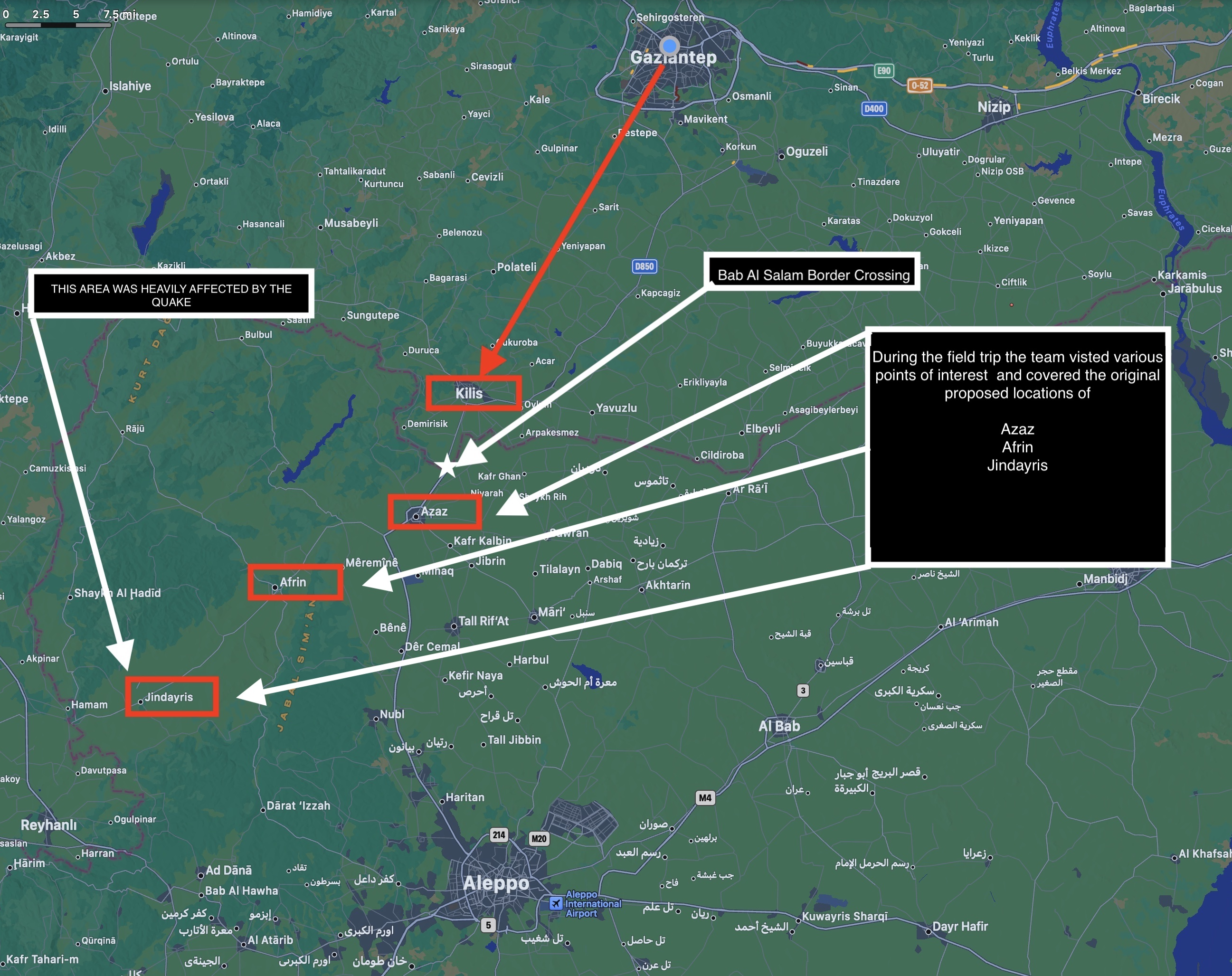 Figure 1 – Map of the locations visited
Figure 1 – Map of the locations visited
- Arrived in Kilis at the IHH warehouse and office at 8:30 AM
- Security briefing/meeting with the team and final specific locations were agreed upon
- Crossed at Bab Al Salam border (UN crossing point) in IHH vehicle
- Registered and photographed at the border
- Two step security checkpoint
- Began periodic team checks (every 60 minutes)
- Drove to the IHH office in Syria on the edge of Bab Al Salam Camp
- Visual assessment of Bab Al Salam New + Old camps
- Visual inspection of a large elevated tank and solar installation
- Visual inspection of an automated chlorination station
- Swapped vehicles and moved off to the agreed field sites with an armed guard onboard
- Visal inspection of IHH activities in Azaz
- We agreed to move directly to the hardest hit area (Jindaris) and then work our way back
- Visual inspection for WASH in Jindaris (latrines, water trucking, tanks, and a clinic)
- Visual inspection for WASH in Afin (cholera treatment center)
- Passed back across the Baba al salam border at 5:30 PM – just before sundown
Ubicaciones
A one day trip is possible. If the team plans on traveling further than Jindaris then an earlier start time would be a good idea as an over night trip at this point would not be advisable. See locations and general assessment of the damage, distance and population density.
| Ubicaciones | EQ – Damage | Need | Displaced | From the Border | Security / Safety |
| Bab Al Salam | Minimal | High | High | 5 minutes | Fairly safe |
| Azaz | Minimal | Medium | Medium / high | 15 minutes | Fairly safe |
| Afrin | Medium | Medium | Medium to high | 45 minutes | Fairly safe |
| Jindaris | High | High | High | 90 minutes | Fairly safe |
Bab Al Salam and the Solar System
The team visited the new and old camps that had an approximate population of 200,000 people. The old camp has been in place for a number of years and is functioning, however it swelled in number since the quake thus creating the new camp and both old and new camps need support across all sectors as the new influx of people is really pushing systems and services that were already heavily labored. During the visit the team assessed a large solarized water tower installation consisting of 3 Boreholes (75, 85, 100 meters deep) pumped via a solar system that feeds a large concrete framed elevated tank with a well managed automatic chlorination system and a raised HDPE pressurized network. AFAD are heavily involved and want to work with Miyamoto. The system is functional and well managed but too small. Pictures of the systems can be found below and on the shared drive.
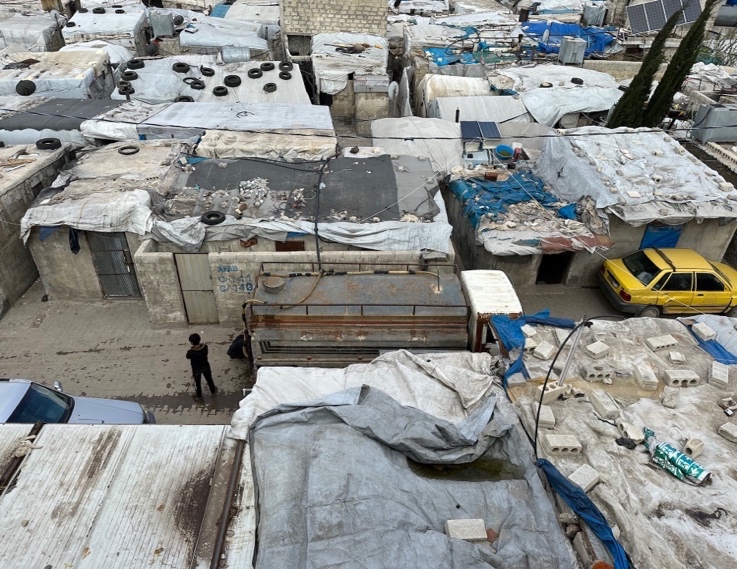
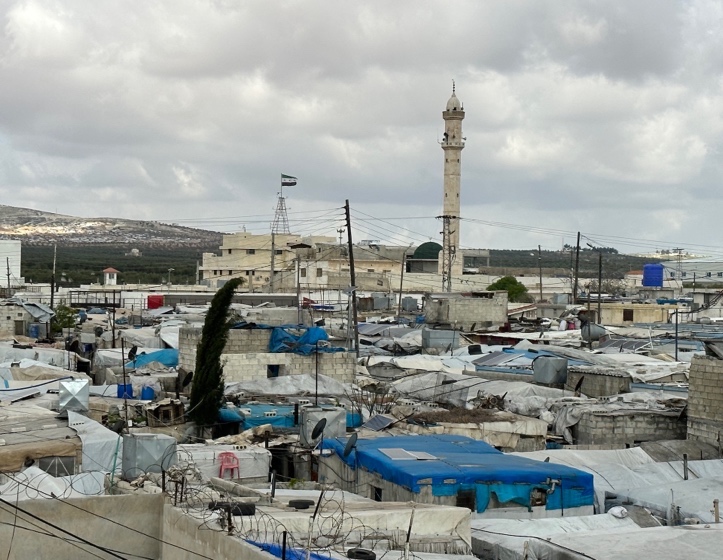
Figure 2 – Bab Al Salam water trucking. Figure 3 – Bal Al Salam New camp
The pictures below show the difference in terms of a solar driven water supply network in the old and new camps of Bab Al Salam
 Figure 4 – Bab Al Salam Old camp Yellow arrows show the level of solariztaion.
Figure 4 – Bab Al Salam Old camp Yellow arrows show the level of solariztaion.
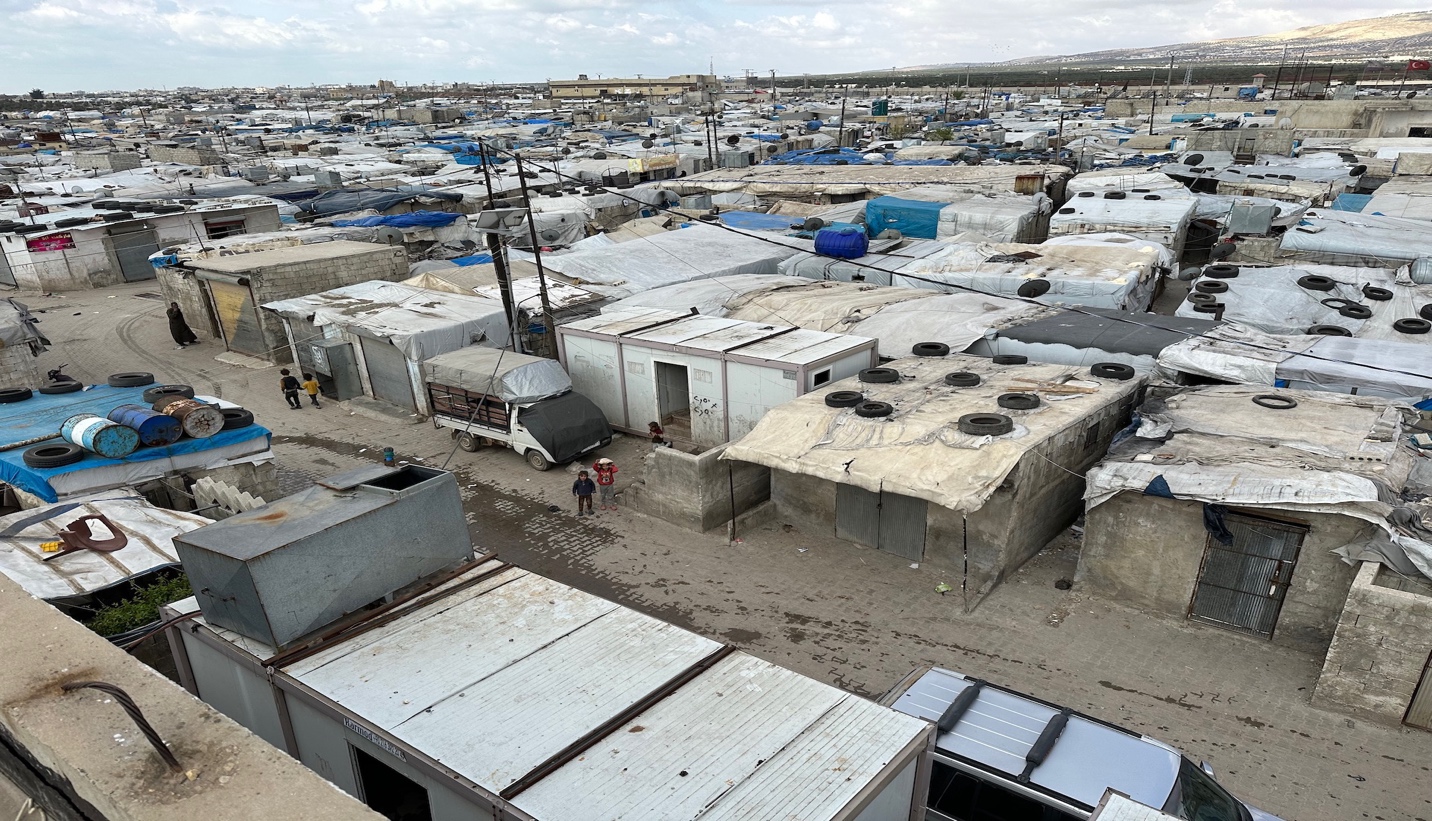 Figure 5 – Bab Al Salam New camp Yellow arrows show the level of solariztaion.
Figure 5 – Bab Al Salam New camp Yellow arrows show the level of solariztaion.
Just the one panel…and its used for lights!
AFAD are keen to see this side of the settlement using a proper system run on solar. I think they could help with the water councils and cut through the red tape
Azaz
The team visited an IHH site that covers a small textile factory, a shop selling clothes from the textile factory at discounted rates for ministry workers, World Central kitchens operation (very well set up), and an IHH run pharmacy/dispensary for primary and secondary healthcare medicines managed by prescription. If we engaged IHH as engineers for the assessment of health facilities they could follow up by providing support to the health facilities by expanding their pharmacy/dispensary at this site. Pictures of the site visit can be found here.
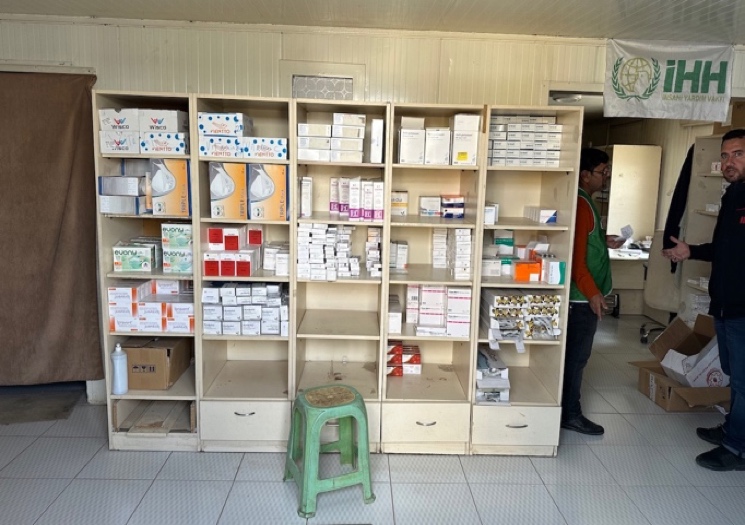
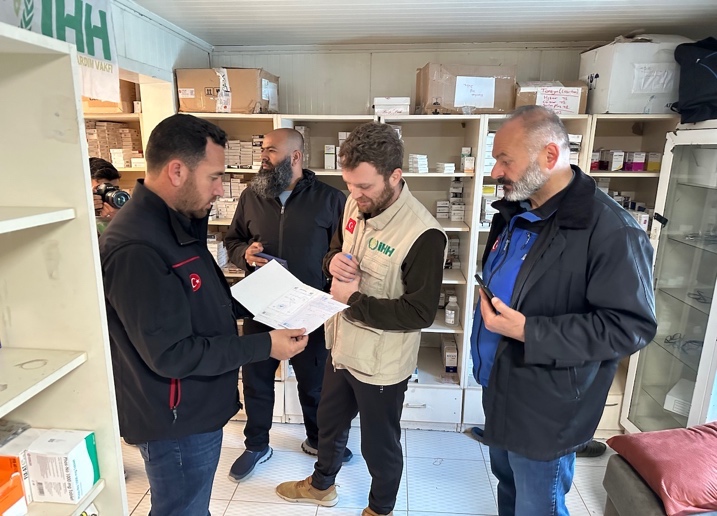
Figure 6 – Dispensary at the IHH pharmacy Figure 7 – Reviewing prescriptions for issuing medications
Afrin
Here the team visited a CTC Cholera Treatment Center. The center was run by MSF in partnership with Al Ameem a Syrian NGO but it was non functional when we visited and had no earthquake damage. It was empty, very dirty, had no patients or staff, abandoned stretcher beds and tough tanks, as well as a lot of leftover stock. Miyamoto inquired in all camps, clinics, and areas we visited regarding AWD (Acute Water Diarrhea) or suspected or confirmed cholera cases and no cases were recorded or reported. Pictures of the CTC center can be found here.
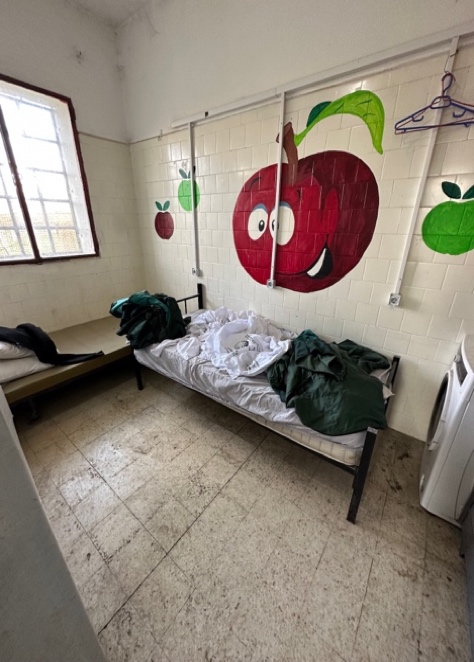
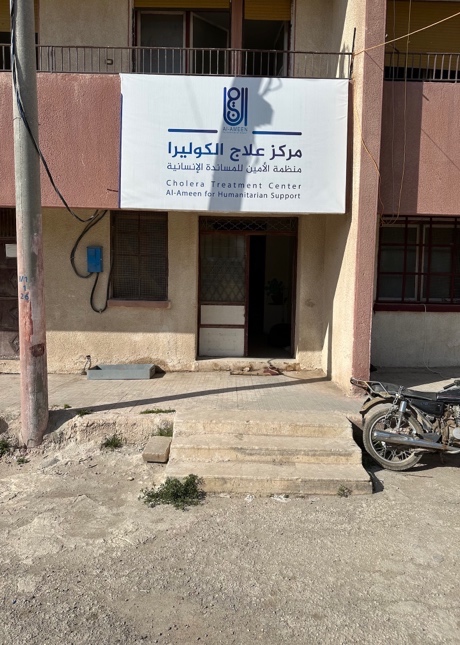

Figure 8, 9, 10 – CTC Cholera Treatment Center run by MSF now out of commission
Jindaris
This was the heaviest hit area from the recent earthquake. It is not as hard hit as Hatay in turkey but it was still very badly damaged. While there Miyamoto visited pre-earthquake and post earthquake camps, a damaged and displaced clinic, and finally a water source serving local water distribution trucks. Pictures for the site visits can be found below and also loaded onto the share drive.
A Pre-earthquake camp for people who had been displaced before the quake due to the conflict. Conditions were quite bad; all dwellings were made from blankets and old ripped plastic sheeting. Toilets were very poorly built and heavily used but functional and kept as clean as possible for a makeshift structure. The water supplied by truck was not chlorinated and was offloaded into household tanks and barrels for storage. Children were unwashed and often had no shoes. There was no open defecation, however the camps were very run down and not receiving any real support. Pictures of the site visit can be found here.
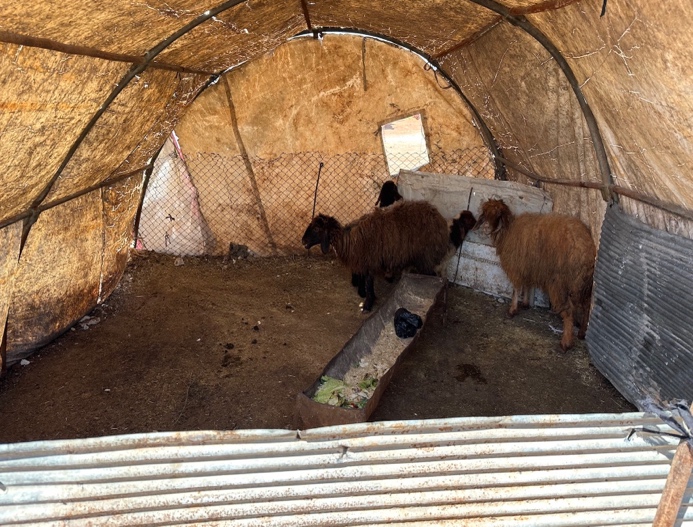

Figure 11 – Pre-earthquake camp water storage not chlorinated Figure 12 – Animals penned to reduce open defecation
It is very encouraging to see that animals are penned and tethered as this helps reduce open defecation and thus the spread of disease.
Unchlorinated and uncovered there were a few steel tanks in the camp but they are receiving very little support and the level of need is high.

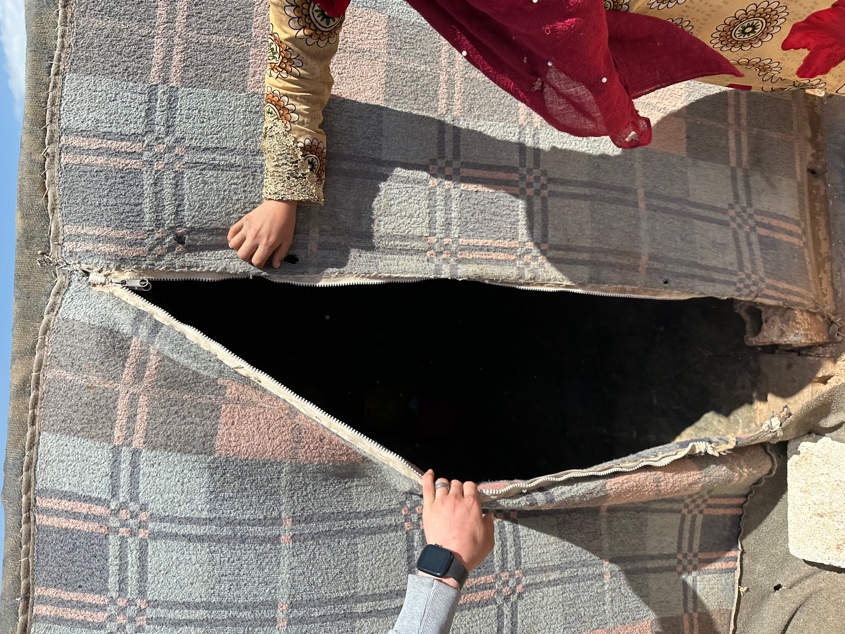
Figure 13 and 14 – Pre-earthquake camps make shift latrines using hand stitched blankets and rice bags
The pre-earthquake camp has been given very little support which is a shame as they are clearly in need–blankets and rice bags do not do well in the wind or rain.
Latrines like this are impossible to clean or empty, and when overused they end up abandoned. Open defecation usually follows and with it the spread of disease.
Post earthquake camp These sites have been given tents and other support as part of the earthquake response. For WASH they were provided support by INGO’s via local NGO’s. They were issued toilets, handwashing stations, showers, and tanks for water storage, however they were in a very poor state. Many of the latrines were backed up/blocked and out of use, lots of empty tanks broken taps and poor plumbing. The water supplied was not chlorinated. There was no open defecation which was surprising considering the state of the latrines assessed. The team did not observe any IEC materials. The lack of consistent oversight has meant that good money and materials have gone to waste. This could be an opportunity for Miyamoto to perform evaluations/field assessments to assess the quality of work diagnose the issues and suggest technical and practical solutions.
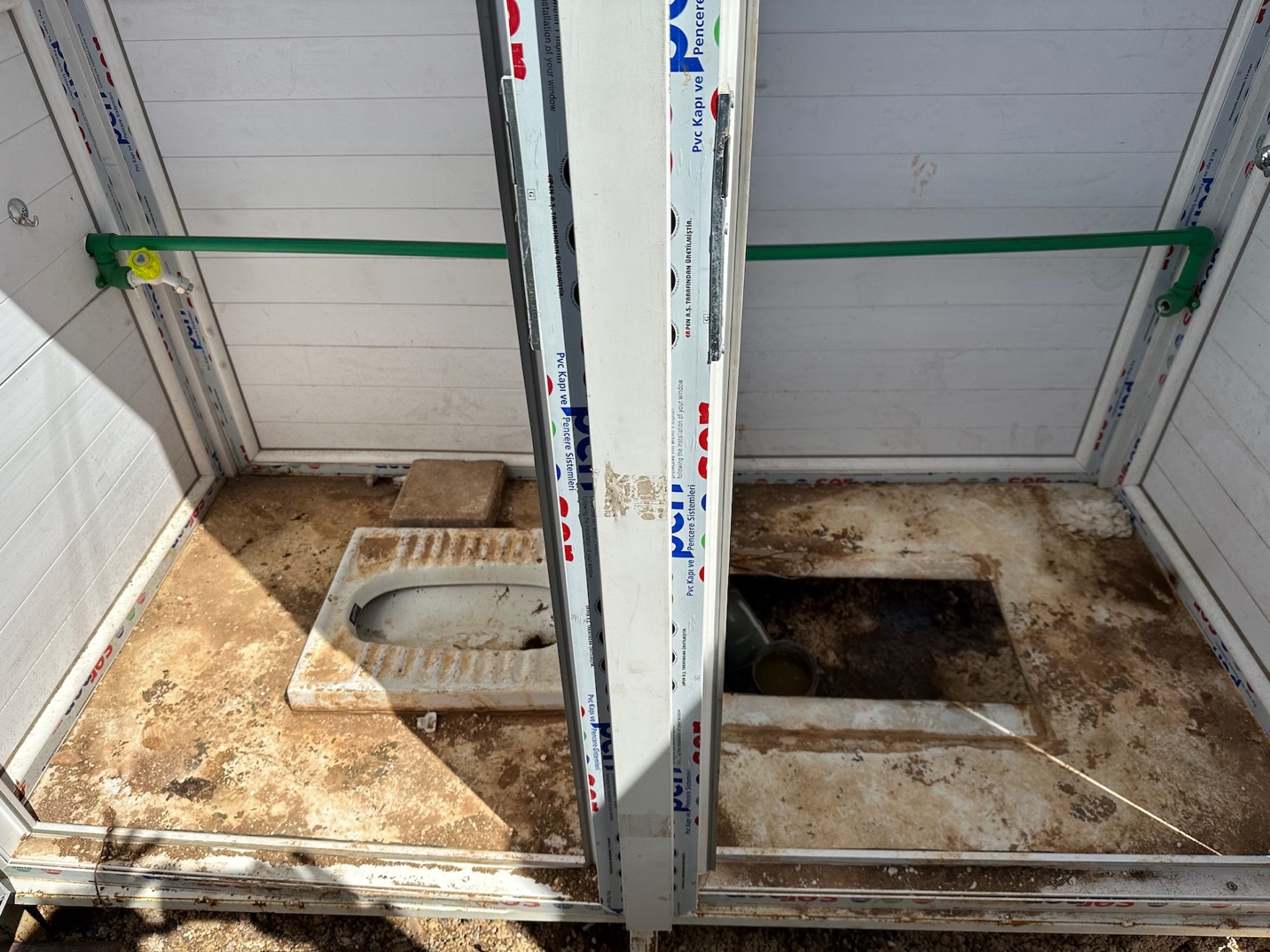
Figures 15 – Prefabricated high quality latrines poorly installed, un-managed, and now out of commission
This is a high quality prefabricated unit and from the outside it looks fully functional. Its now blocked with human waste, and no contractor is going to want to work on something that is covered in feces and smells of urine. There were a number of units in this state.
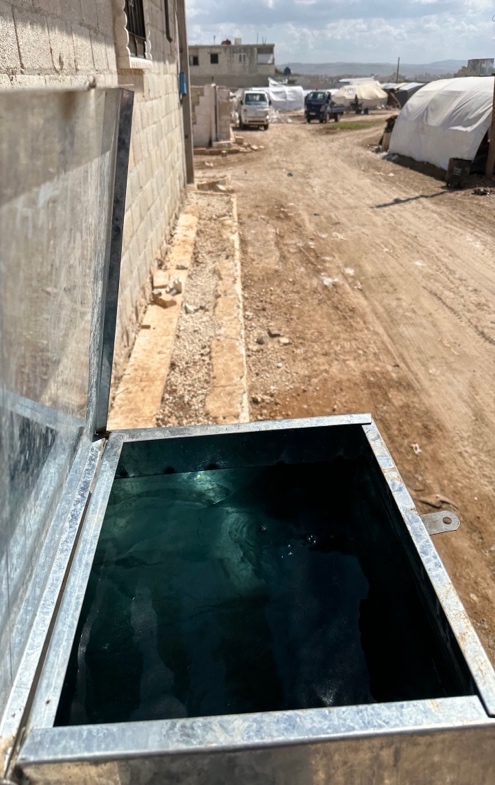
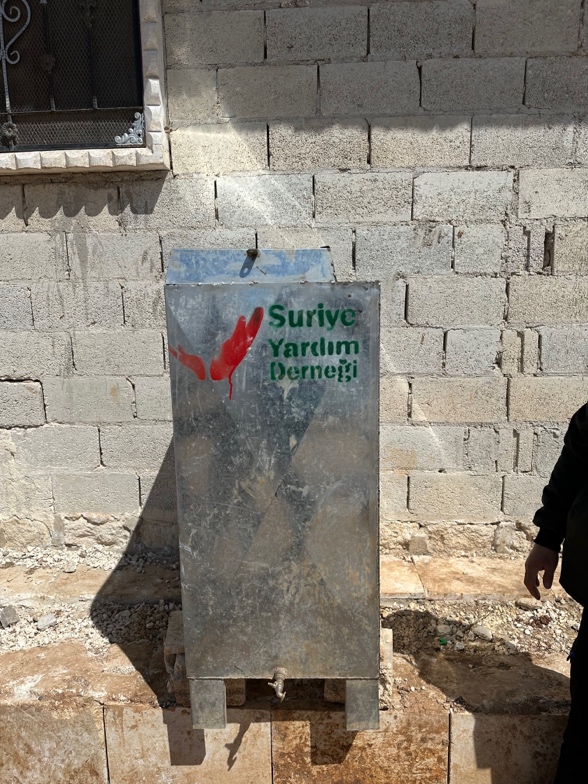
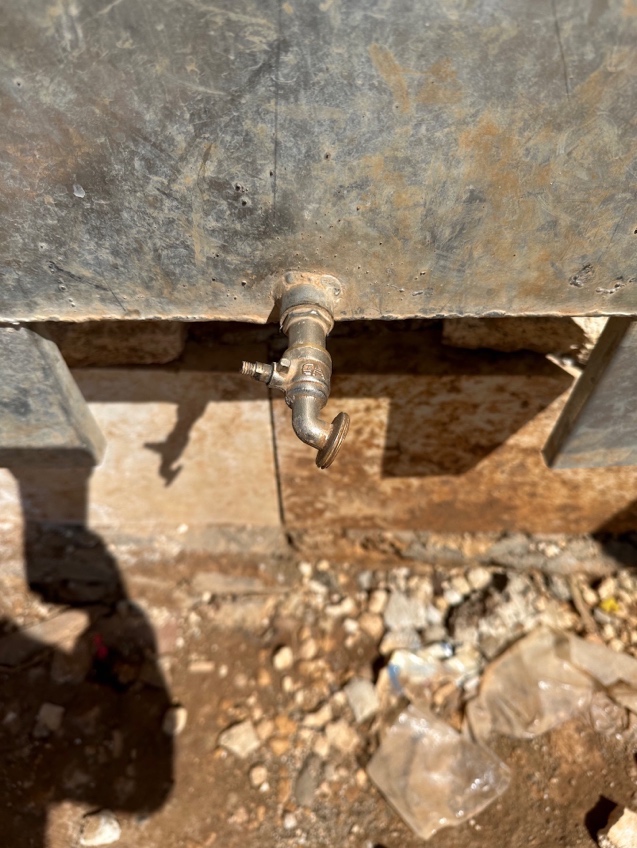
Figures 16, 17, and 18 – Good quality steel tank, full / unchlorinated, not maintained – tap broken – out of commission
There is a lot of good quality materials coming across border but they not being well maintained.
Without good operation and maintenance, even good quality installations will breakdown.
Water appeared to be be clean but was not chlorinated.
The displaced clinic – this was a three story structure, well appointed and in fairly good condition. There was cracking in almost all rooms not heavy but enough to cause concern. The clinic had moved its operations outside into tents. There were approximately four staff and ten patients. The set up was quite basic with running water and hand sanitizer and soap observed. The clinic had a basic solid waste management system with segregation of waste. The first quake caused light damaged to the structure and the second quake made the damage even worse. The medical team are using the toilets inside the clinic. There were no confirmed cholera cases at this site but there were a few cases of AWD and some skin infections, but not at worrying levels. This is a good example of a site that can be assessed and recommissioned thus allowing the clinic to function and serve its catchment community.

Figure 19 – Tent clinic – well run with approx. 10 patients in 4 tents. Damaged building is across the street
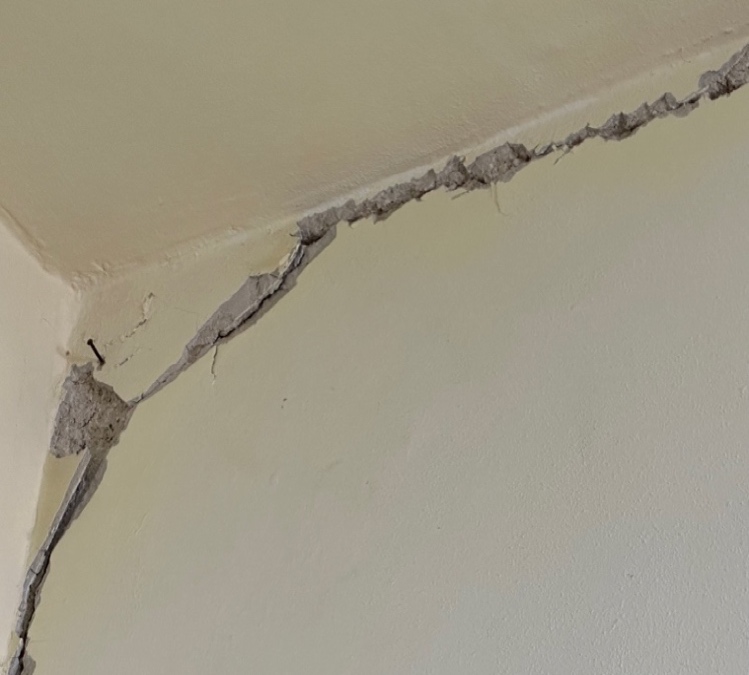
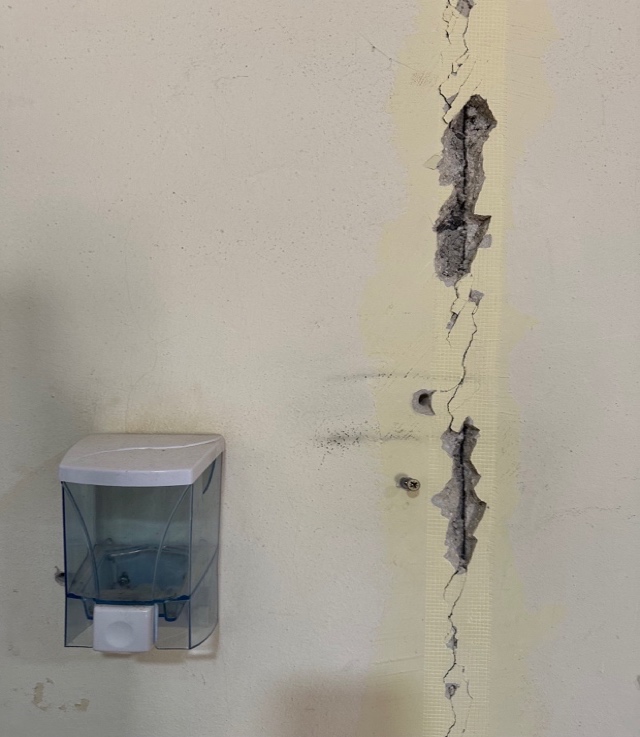
Figure 20 and 21 – Shows extensive light cracking throughout the 3 story structure – clinic is now in tents outside.
Water source this site was in the middle of the town currently supplying a number of trucks and tractor trailers approx. 2,000 / 2,500 liters in size. The source owners are charging 30TRY per 1M3. The water supplied is untreated by the team managing the source. One driver advised that he uses HTH powder for chlorination but he didn’t seem clear on dosing levels or contact times. These trucks are serving camps and communities and they are privately run and also run by local organizations. Transportation times, delivery locations and fuel consumption were not clear.

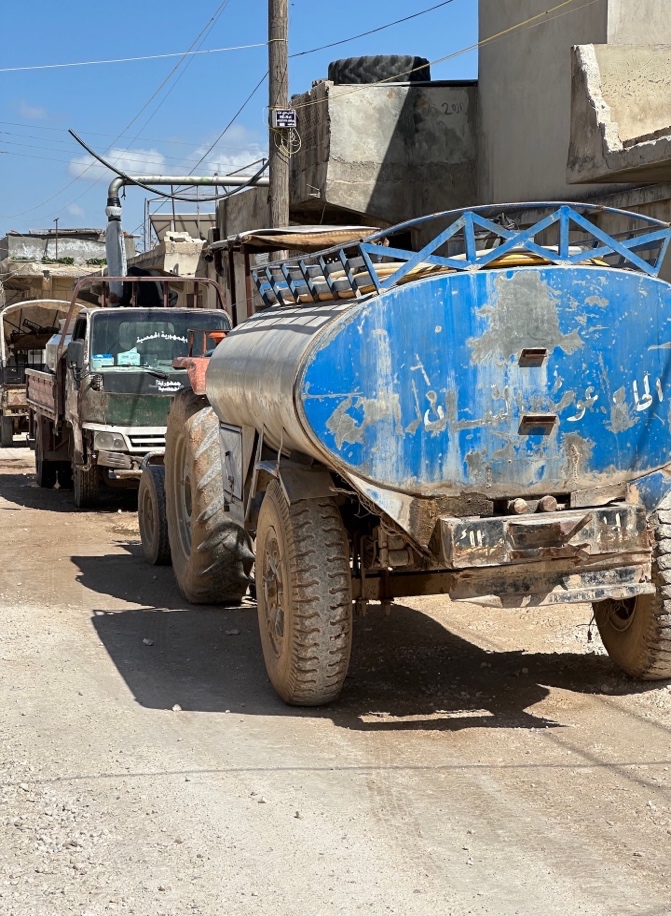
Figure 22 and 23 – Water source for local water trucking, chlorination performed by drivers not checked and not trained
Figure 24 and 25 – Household tough tank and raised water network pipe system. Water-tower or water truck fed.
Some locations have a raised water pipe network pressurized by solar and gravity and at other sites water is trucked in
AFAD are keen to work with Miyamoto on water supply in Bab Al Salam
Security and Safety
There is only so much that can be gleaned from a one day visit, however Miyamoto performed a lot of due diligence and had many discussions with people involved in cross border activities. During the recent trip Miyamoto learned a lot about the safety and security context, the application procedure and cross boarder activities. The first deployment was small, low profile, and took place without incident. If field visits are performed in the future its recommended that they take place during daylight hours, that they are low profile with a trusted partner and with endorsement/support from AFAD. This will help to minimize risk to the team as much as possible. In 2022 there were 876 reported incidents of abduction, kidnapping and forced disappearances, it would be interesting to know how many of these took place in Turkish controlled areas. Its also worth noting that the roads were damaged, and somewhat chaotic. The risks for an RTA were high and would be tricky to deal with if a serious RTA took place.
Relationships
AFAD – Mr. Shawallie AFADs representative for Syria was very friendly and wants to work with Miyamoto in Bab Al Salam. I think this is worth pursuing this as Miyamoto is showing we are working closely with AFAD on both sides of the border could be good for us. The Solar water supply CN could be a good opportunity for this to take place.
IHH – Hamdi and Segkin were our main points of contact and were a pleasure to work with. The visit was good for cross border work but also good for the long-term relationship. I believe reaching out in countries where we overlap could be good. There is also an upper level of senior managers from Istanbul who we briefly met in Kilis. If we pursue a relationship with IHH I would think it would be good to try and set a meeting with them.
ACU – Assistance coordination Unit is a Syrain organization based in Turkey they are proactive, well connected and trusted. Miyamoto has had initial meetings with ACU and developing a partnership with them could lead to further opportunities and also support for Syria.
FCDO – Magnus, whom we have an established relationship, is based out of Gaziantep for the next five months and his focus is on NWS. He is informed on WASH and we had a meeting just before I left. I think if we share the Syria trip pictures and report and the solar concept note FCDO could potentially fund it.
Communications
- Turkish SIM cards do not work well across the border.
- Internet connection was strong almost the entire time and whats app worked well
- Could travel with a sat phone but unsure how it would be received if searched
- Any future trips cross border I would suggest a local check in and reduce it to every two hours.
Recommendations/Suggestions
- Arrange another IHH/expat mission for two days to collect information for new proposals
- Security check in cut back from 60 minutes to local check in and to every two hours
- Develop the relationship with AFAD they are keen on Bab Al Salam and Solar installation
- Single point of contact with IHH/ACU/AFAD for applications trip planning etc
- If we focus on X border works we should concrete on Bab Al Salam and Jindaris as need is highest there
- Approach ECHO to gauge interest
- Share more information with Magnus from FCDO to gauge interest in funding works x boarder
- Propose a trip to NWS in partnership with ACU in relation to Heath facilities and cholera
- Share concept note for field assessment / evaluation of poor quality work on behalf on donors
- Place all WASH assessments into ARC123 software in perpetration for next field assessment

